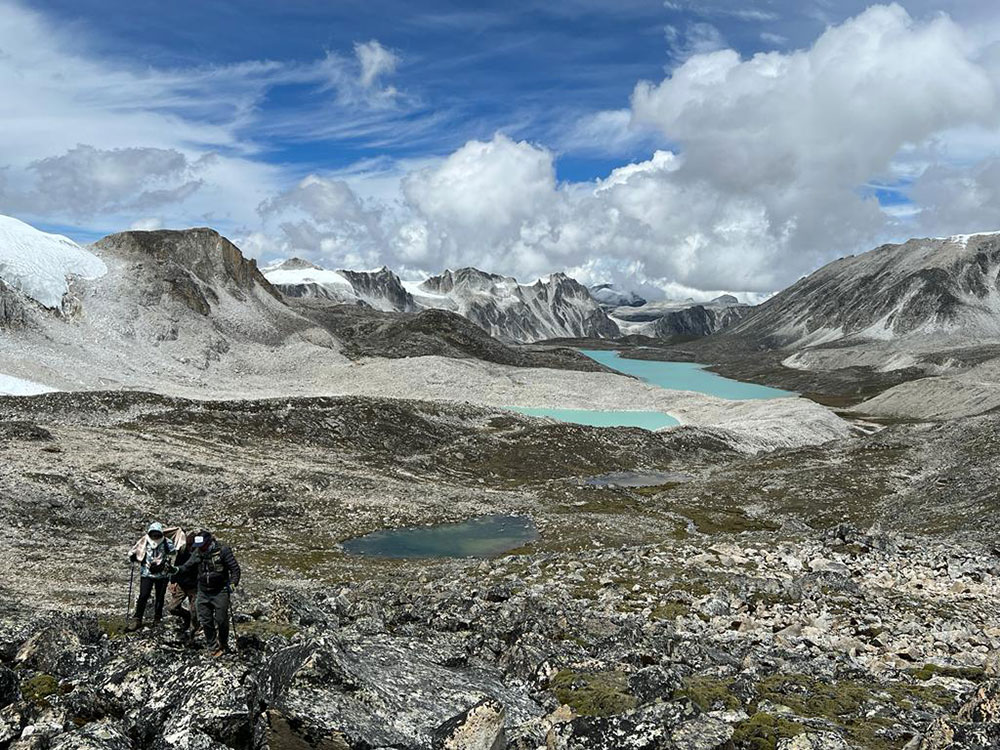Bhutan’s Snowman Trek is known as the most difficult trekking route on earth. A veteran trekking guide says that, at some stage of this 24-day excursion, you cry. So what does this tell us about the Snowman Race coming up in October?
There are a number of ultramarathons around the world that claim to be the “toughest”. Most people do not know what it is like to struggle across a desert of dry sand or through an animal infested tropical forest, but a professional trek director describes the Snowman Race as a “gruelling”, “brutal”, and “unmatchable” challenge.
A marathon is a 42-kilometre race, and the world record of 2 hours, 1 minute and 39 seconds is held by a Kenyan runner. The Snowman Race is about five marathons in length. Professional trekkers are proud to have crossed the 220 kilometres or so, from Gasa to Bumthang, in 14 days. Starting October 13, the Snowman Race will be launched as a global event, with 30 professional athletes racing this stretch in five days. It is described by race monitors as the most remote ultramarathon that climbs to higher altitudes than any other race, at nearly 5,500 metres, or 18,050 feet.
This is the first Snowman Race, with 12 women and 18 men, including eight Bhutanese athletes. Most of the run is above the tree-line, across the rolling Alpine grasslands and over high ridges, on the narrow rocky paths hugging the sheer mountainsides as they cross 11 mountain passes. The athletes will spend four nights in camps that are 4,500 to 5,000 metres (over 16,000 feet), managed by professional Bhutanese trekking companies.
The runners start at 6.00 am every morning and cover about 45 kilometres a day. It is clocked as a daily race for five days and the Snowman Race champions – male and female – are declared after their daily timings are added up for the final results.
As much as it is an athletic phenomenon, the Snowman Race is an environmental and anthropological excursion. It is inspired by the vision of His Majesty Jigme Khesar Namgyel Wangchuck – it symbolises the Royal interest in the physical wellbeing of the people, concern for the health of the ecology, and prescience to preserve Bhutan’s cultural heritage.
The course runs through a number of sparse highland settlements located along Bhutan’s northern mountain ridges. The semi pastoralists of the region, like the people of Lunana, have always used the paths to trade their yak dairy products for essentials like rice, salt, and utilities. They bought essentials from traders of Laya, five days away, who used mules in summer and yaks in winter to carry goods higher into the mountains.
The runners will experience the lives of Bhutanese highlanders that are tuned to the harsh climate and rugged terrain. In the past, men traveled in groups to shop in the lower regions. It was not long ago that traders had a silent understanding that, if someone fell off a cliff the others would continue their journey because it was not possible to rescue people or goods from the deep gorges.
They will also see Lunana communities being transformed. The lives of nomadic herders changed dramatically after the government allowed sustainable harvesting of Cordyceps Sinensis, the much sought-after parasitic fungi used in Himalayan medicine. The Cordyceps grows in Bhutan at elevations above 14,000 feet and, in 2022, fetched wholesale prices up to Nu 2.851 million (US$36,000) for a kilogramme. For many Lunaps, the eight-day treacherous trek to trade for essentials has become a 30-minute helicopter ride.
International race monitors have identified high-risk places along the trail and the Snowman Race secretariat has organised work on the most critical, where new tracks need to be built and extremely narrow portions to be widened. The Snowman Race has been planned along international rules of competition and safety standards, with human and digital support.
A priority for the Snowman Race is safety. Organisers have insisted on weather experts and technology to allow the start of the race each day, drawing lessons from the experiences of adventure events around the world. Medical coverage arranged for the athletes includes treatment and evacuation. The athletes will carry devices to stay on course and also be tracked all the way with GPS.
The primary purpose of this athletic venture is to draw global attention to climate action. The stark effects of climatic patterns of the fragile mountain ecosystem and the risk to human existence is visible to the naked eye in this terrain. Local residents point out the changes in topography that they see every day, from the melting of snow on mountains peaks to the increased movement of glaciers, sometimes resulting in the outburst of glacial lakes.
Racers experience long moments of complete solitude, trudging for hours alone with their thoughts. The reward is the raw beauty of the Himalayas in all its glory. The daily traffic of motor vehicles and humans is far away. They are more likely to encounter the Blue Sheep, Sambar, Musk Deer, Mountain Pika, wild boar.
The trail cuts through what the local people call baeyul, a hidden paradise where over 50% of the land cover is protected areas and home to more than 11,000 species of rare flora and fauna. According to the International Union for Conservation of Nature (IUCN) Red List, at least 21 species are critically endangered, 43 species endangered, and 70 species vulnerable in Bhutan.
They also run past at least eight of Bhutan’s 20 virgin peaks that are taller than 7,000 metres or 22,000 feet. Among these is highest unclimbed peak on earth, the 7,570 metre, or 24,836-foot, Gangkar Puensum.
Today, the 30 athletes are training in 10 different countries. Unlike the Bhutanese nomads their stamina and prowess comes from sophisticated training and race experience. But the rugged highlander and the ultramarathon runner share the deep reverence for nature and the values that shape human life. They are people who care – people who dare.
Contributed by
Dasho Kinley Dorji


